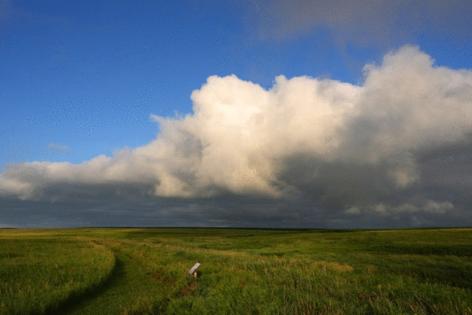What are the best views in Minnesota? Here are our picks
Published in Travel News
MINNEAPOLIS — Hello, gorgeous! Minnesota may be the Land of 10,000 Lakes. But is it also the land of 10,000 beautiful views?
That many at least. But what are the best of the best, the loveliest vistas in the state, the sort of views that give you a catch in the throat, that give literal meaning to the cliche “breathtaking”?
We’ll get the debate started with our reporter-curated roundup of our favorite vistas and views, overlooks and panoramas, both urban and wild, high up and down to earth, spectacular but also quietly enchanting.
Touch the Sky Prairie
Where it is: In the far southwest corner of the state, 15 minutes northwest of Luverne and Interstate 90. An easy 1-mile hike on a mowed southbound path through prairie grasses brings you to a waterfall.
What you’ll see there: A vast expanse of native tallgrass and purple prairie clover catching the rays of the golden sun. Water from the creek babbles as it passes over pink quartzite boulders. You might see families of deer and pheasants, perhaps even a beaver. You’ll feel the mosquitos; bug spray recommended.
Why we like it: Walking along the trails at Touch the Sky Prairie allows you to imagine what the vast prairies might have been like before combines and Walmarts. There’s a rugged beauty in the landscape at the 1,000-acre preserve, the legacy of internationally renowned wildlife photographer Jim Brandenburg. If you’ve never experienced a wild prairie, this is a walk that will help you understand what all the fuss was about. And then, after the hike, you can return to modernity, back to the parking lot, where you can see walls of cornfields and rows of windmills stretching far out into the distance.
— Jp Lawrence
Stone Arch Bridge
Where it is: The east portal is in Father Hennepin Bluff Park, at the end of the Sixth Avenue SE cul-de-sac in Minneapolis. The west portal just reopened.
What you’ll see there: The Mississippi River gushing down St. Anthony Falls, with the arches of the Third Avenue Bridge as a backdrop. To the west, a wide-open view of downtown Minneapolis’ tallest buildings. To the east, the historic Pillsbury Mill and its iconic neon sign.
Why we like it: Whether it’s the smokestacks and silos that line the river’s banks, or the informational displays on the bridge’s rails, you can be transported back to when wheat was king in the Twin Cities. But it’s the roar of the falls that will entrance any visitor, demonstrating the true might of America’s river. The best time for viewing is at sunrise or sunset, when the orange sky fills in the skyline, reflecting off the water. And if the breeze is just right, you can catch the slightest mist from the falls.
— Lincoln Roch
Palisade Head
Where it is: Part of Tettegouche State Park on Hwy. 61 off mile marker 57 northeast of Silver Bay.
What you’ll see there: Stunning panoramic views of Lake Superior from the top of a headlands about 300 feet above the water. You might also see some rock climbers on ropes ascending the steep cliffs, or even slackliners balancing high above the water.
Why we like it: In flattish Minnesota, it can be hard to find something fairly vertiginous. But our version of the Cliffs of Moher is conveniently located just off the Hwy. 61 drag. A short uphill drive on a narrow road and into a parking area and there it is, scenery galore without much effort to get there.
— Richard Chin
Ely's Peak
Where it is: On the outskirts of southwest Duluth off Beck’s Road at 123rd Avenue W. Follow signs for the Superior Hiking Trail.
What you’ll see there:All the shades of green for miles and miles in every direction with the St. Louis River Estuary winding through it. (Unless it’s fall, arguably the best time for this climb, when the view offers a bold palette.)
Why we like it: The journey is as great as the destination. It’s a short but somewhat challenging hike to get to the highest point, less than 2 miles round trip, over stones and roots and huge boulders. It sometimes calls for all available limbs to hoist yourself to the next point. There are plenty of plateaus that offer a good enough view along the way. But the very top is worth all the effort. While you’re on these trails, visit the Duluth, Winnipeg and Pacific Railway train tunnel that cuts through the hill. It offers the opposite of a view: cool darkness.
— Christa Lawler
Endless Bridge
Where it is: One of the public spaces off level four of the Guthrie Theater, 818 S. Second St., Minneapolis.
What you’ll see there: This outdoor viewing area with tiered seating is at the fingertip of a cantilevered arm jutting 178 feet from the theater building and 55 feet above West River Parkway. From this elevated platform, you can see and hear the powerful Mississippi River tumbling over St. Anthony Falls, study the graceful curves of the Stone Arch Bridge and the Hennepin Avenue Bridge, and see historic grain mill structures and modern skyscrapers of downtown Minneapolis.
Why we like it: Though you can visit the Endless Bridge whenever the theater building is open, you’re typically there with a drink in your hand, killing a little time among other nicely dressed people in the early evening light, anticipating a theatrical performance. It’s not unlike other glamorous outdoor theatrical balconies like the Metropolitan Opera House’s balconies overlooking Lincoln Center in New York City or Palais Garnier’s balconies overlooking the Place de l’Opera in Paris. But do those places offer a view of one of the world’s greatest rivers?
— Richard Chin
Hawk Ridge
Where it is: At the Hawk Ridge Bird Observatory overlook inside the Nature Reserve in Duluth’s Lakeside neighborhood. The overlook is on a section of E. Skyline Parkway off Glenwood Street.
What you’ll see there: In the summer, beautiful shades of green and the vast, blended horizon of sky and Lake Superior, unencumbered by civilization when looking east.
Why we like it: When birds are migrating and hundreds of birders are gathered, it’s a bustling place to learn and, well, bird-watch. But when it’s not bird-watching season or peak fall, it’s a peaceful place to walk trails or stare off into that big, blue space beyond.
— Jana Hollingsworth
Split Rock Lighthouse
Where it is: Several minutes down a trail from the right of the parking lot, find a lengthy set of wooden stairs that lead to Lake Superior. The actual address is 3713 Split Rock Lighthouse Road, Two Harbors.
What you’ll see there: An on-the-ground view of the lighthouse from afar, sometimes accompanied by emerald swells of Lake Superior and woodsy splendor geared to the season you’re in.
Why we like it: It’s a perfect spot to contemplate the lore of shipwrecks and the colossal power of the Great Lake. You can perch on a boulder and imagine the feat in 1909 of hoisting construction materials 110 feet to the top of that massive cliff. And on the way down the stairs, there are spots to stop and take in different perspectives.
— Jana Hollingsworth
High Bridge Overlook
Where it is: Near Smith and Cherokee avenues, at the south end of St. Paul’s High Bridge.
What you’ll see there: A scenic overlook that’s part of the Cherokee Regional Park on the Mississippi River bluffs gives you a panoramic view of downtown St. Paul including the domes of the Cathedral of St. Paul and the Minnesota State Capitol and the Mississippi River rolling far below.
Why we like it: There’s the view, of course, but also the setting. The overlook is decorated with a well-tended little garden created and cared for by volunteers of the Cherokee Heights Garden Club.
— Richard Chin
Frontenac State Park
Where it is: On the west bank of the Mississippi River, about a 10-minute drive from both Red Wing (to the north) and Lake City (to the south).
What you’ll see there: A breathtaking look over Lake Pepin, the widest navigable portion of the mighty Mississippi. One of the lookouts also includes a picnic area perfect for slowing down and taking in the view.
Why we like it: This is a nature-lovers’ paradise. More than 260 species of birds have been found making their way through Frontenac — the most of any park in the state — so be sure to bring your binoculars. While you are taking in the views from the 430-foot-high limestone bluff, also take a moment to appreciate some Minnesota history: 102 years ago, the lake you are looking down on is where water skiing was invented. The picnic spot is also easily accessible, with parking within steps of the lookout. Though, if you are looking for an adventure, hike the steep bluff-side trails down to the stony shore and back up to the outlook.
— Sean Baker
Como Park's Great Lawn
Where it is: 1199 Midway Pkwy., just east of the East Picnic Lot in Como Park, St. Paul.
What you’ll see there: A large, grassy meadow, the sort of big, wide-open green space that’s hard to find outside of a golf course. With lots of space unobstructed by trees or buildings, it’s a great place to fly a kite, toss a Frisbee or stake out a picnic spot far away from anyone else. And you might see an eagle undergoing rehab there. It’s so roomy, the University of Minnesota Raptor Center uses it to exercise large birds on 300-foot-long tethers.
Why we like it: Maybe not as dramatic as views featuring a body of water or an elevated overlook, there’s still something pleasing, especially in the early evening, standing in an open space with such an expansive view of the sky and earth. The lawn also gently slopes up to a single, striking pine tree on the top of the hill near the statue of Johann von Schiller.
— Richard Chin
Aiton Heights Fire Tower
Where it is: Itasca State Park. A 1-mile in-and-out hike takes you to the 100-foot-tall tower, then climb 135 steps to the tippy-top. Wilderness Drive brings you to the tower parking lot for the best point of entry; hiking from Douglas Lodge is double the distance, but from the parking lot, it’s family-friendly and more accessible.
What you’ll see there: Panoramic views of Minnesota’s first state park from 1,662 feet above a lush canopy of historic northern hardwood forest. You can spot eight of the park’s 100 lakes. Beware of going on a particularly windy day, but do plan to climb in autumn for the most gorgeous scenery. Closed during the winter.
Why we like it: The Mississippi Headwaters is, of course, the centerpiece and crown jewel of Itasca. But the less beaten path, away from those slippery rocks, is worth checking off the bucket list. Aiton Heights, built in the 1920s and moved to Itasca in 1937, is on the National Historic Lookout Register. To climb it is exhilarating, good exercise and better conversation. On a recent visit, a group of teenage boys said the views from Aiton were “mad good” (that’s slang for excellent). Other hikers afterward stopped by Douglas Lodge for a bite and to trade stories about the climb. If you’re afraid of heights, swing by Peace Pipe Vista or Preachers Grove instead.
— Kim Hyatt
Irvine Park
Where it is: Near Walnut and Exchange streets, St. Paul.
What you’ll see there: A quiet little square park surrounded by historic homes with a graceful fountain in the middle and a gazebo shaded by large stately oak trees.
Why we like it: Irvine Park’s charm can arrive like a surprise. You go a few blocks from the congestion of downtown St. Paul and, suddenly, you’re in a little oasis that seems like it belongs to another place, maybe another century.
— Richard Chin
_______________
©2025 The Minnesota Star Tribune. Visit startribune.com. Distributed by Tribune Content Agency, LLC
















Comments